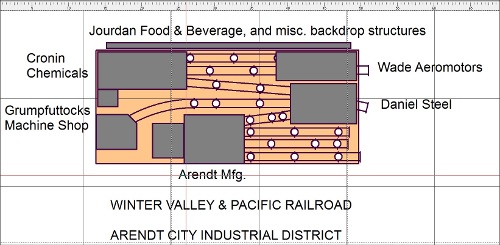Well, almost.
I received an email from a Dennis McGeen on 21st Oct 2012 regarding a layout he is building based on the design concepts in my now dismantled Case Industrial suitcase layout. The Case Industrial layout was featured in the late Carl Arendts Small Layout Scrapbook. Here is what Dennis wrote:
“I just wanted to let you know how much I have enjoyed your amazing Case Industrial layout and trackplan (and your website). Ive admired Case Industrial many times on Carl Arendts micro-layout site and it is probably my favorite layout there. As matter of fact, I like your plan so much I am building a layout very much inspired by it. I have a 15 inches x 36 inches layout base for the industrial district of my Winter Valley & Pacific Railroad. It will be largely set in the anthracite mining region of Pennsylvania in the 1960s and 70s though I will operate some sessions in the 1950s and some in the 1990s through today, with appropriate locos and rolling stock for each era.

I added one extra sector plate and extended the siding lengths. I tried to take the basic elements of Case Industrial (passing track, a few sector plates, inbound storage, outbound storage, and transfer track) and create something a bit different in appearance … But there are only so many ways in such a small space to arrange those elements! I think you came up with the perfect small switching layout plan. So my layout looks like an upside-down version of Case Industrial, with the extra sector plate and the slightly longer tracks. The track is installed on the foam layout base with foam roadbed underlayment, and I am ready to build the sector plates. Anchor points are marked for the plates to pivot on and track is cut to fit already.”
Following some further correspondence with Dennis, he sent me some photos and a track plan of his layout, and some more information:
“The layout fits into a plastic storage box with lid, of the “under-bed” variety of sealed storage container. This will provide dust protection and storage ease, as well as protection from curious felines and canines in my home when not actively in use. The box dimensions, coupled with the varnished pine frame around the layout, determined the 15″ x 36″ footprint. Building papers have been prepared and printed using texture images I imported into the excellent Model Builder software from this website: http://www.modeltrainsoftware.com/modelbuilder.html .

All buildings will be scratchbuilt to fit the site using foamcore board, matte board and/or sheet styrene with additional details. Rolling stock will be a couple of entry-level Bachmann HO scale MDT Plymouth diesel locos, to be repainted and re-lettered, with an entry-level 0-4-0 steam tank loco added for earlier era sessions. Rolling stock will be refurbished HO scale cars found at train swap meets, with new couplers, trucks and/or wheelsets, as well as some detail and paint touchups and repairs to breathe new life into the gently used (or heavily used) rolling stock. The freight cars will not be as fine-scale as todays offerings but they should still look nice, be sturdy enough to stand up to an occasional nudge from a playful housecat, and be a fond reminder of the style of entry-level rolling stock and train layouts of my childhood in the 1970s.”
While the layout being built by Dennis is larger than Case Industrial, and not within the confines a suitcase, the size of the Winter Valley railroad is still constrained by the size of its home (a plastic storage box). The track plan also has the same design elements, and the Winter Valley will still feature scratchbuilt buildings and so is still in keeping with the over all concept, construction parameters and constraints of the original Case Industrial layout.
0 Comments